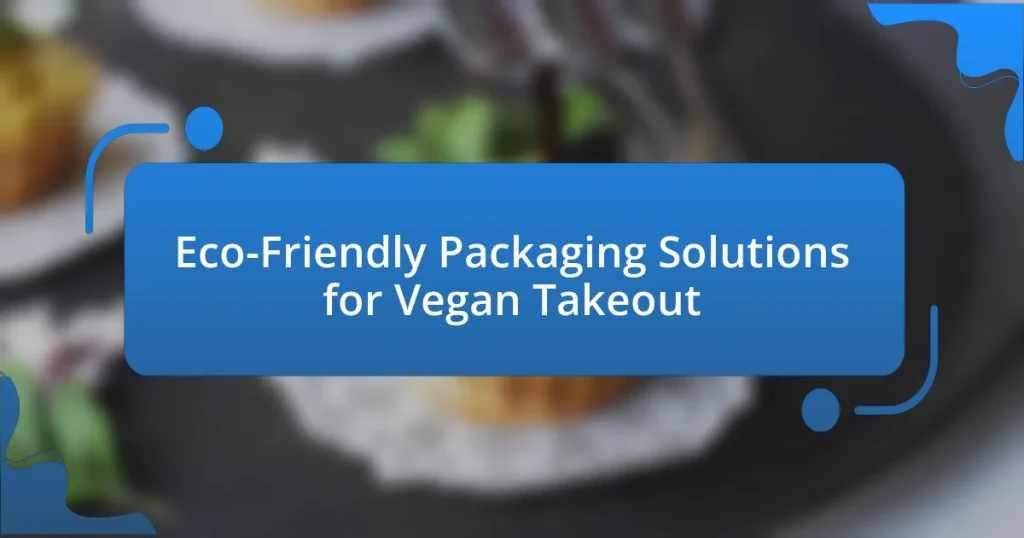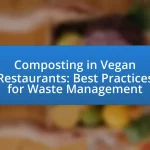Eco-friendly packaging solutions for vegan takeout encompass biodegradable containers, compostable bags, and plant-based materials, which significantly reduce environmental impact compared to traditional packaging. These sustainable options, made from materials like sugarcane, bamboo, and cornstarch, align with vegan values by promoting waste reduction and resource conservation. The article explores the differences between eco-friendly and conventional packaging, the materials commonly used, their environmental benefits, and the challenges businesses face in implementing these solutions. Additionally, it highlights the importance of consumer education and the measurable benefits of adopting eco-friendly practices in the food industry.
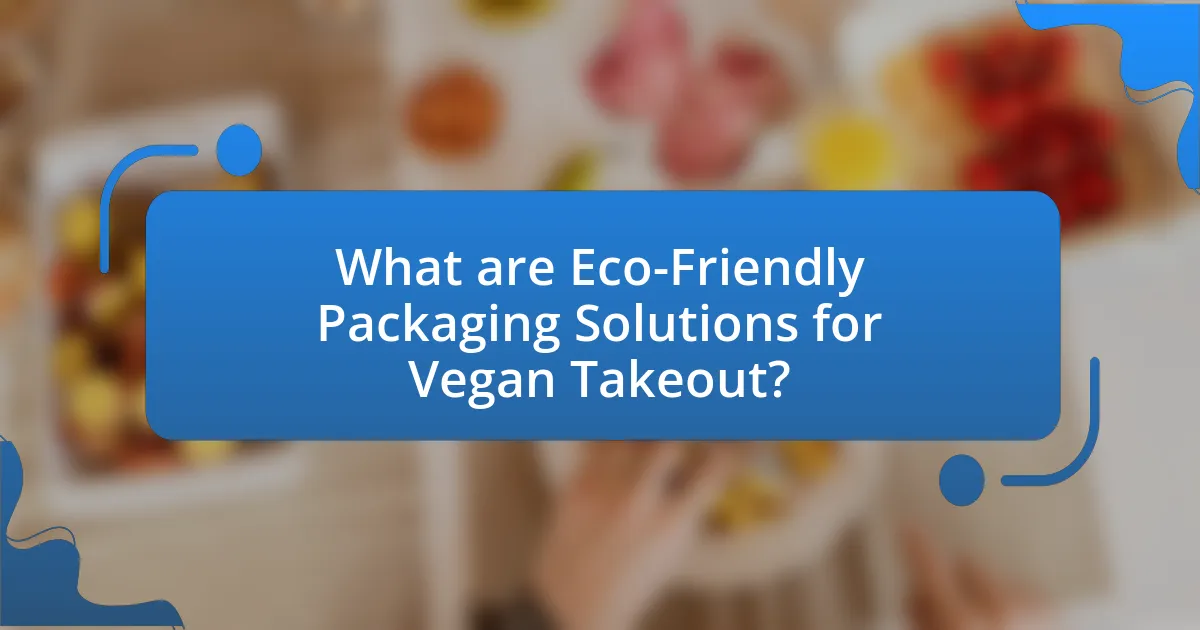
What are Eco-Friendly Packaging Solutions for Vegan Takeout?
Eco-friendly packaging solutions for vegan takeout include biodegradable containers, compostable bags, and plant-based materials. Biodegradable containers, made from materials like sugarcane or bamboo, break down naturally and reduce landfill waste. Compostable bags, often made from cornstarch, decompose into nutrient-rich compost, supporting soil health. Additionally, plant-based materials, such as those derived from mushrooms or seaweed, offer sustainable alternatives to traditional plastics. These solutions not only minimize environmental impact but also align with the values of veganism, promoting a healthier planet.
How do eco-friendly packaging solutions differ from traditional packaging?
Eco-friendly packaging solutions differ from traditional packaging primarily in their materials and environmental impact. Eco-friendly packaging is made from renewable, biodegradable, or recyclable materials, such as plant-based plastics or recycled paper, which reduce waste and pollution. In contrast, traditional packaging often relies on single-use plastics and non-biodegradable materials, contributing significantly to landfill waste and environmental degradation. For instance, a study by the Ellen MacArthur Foundation highlights that only 14% of plastic packaging is recycled globally, emphasizing the unsustainable nature of traditional packaging compared to eco-friendly alternatives that promote a circular economy.
What materials are commonly used in eco-friendly packaging for vegan takeout?
Common materials used in eco-friendly packaging for vegan takeout include biodegradable plastics, recycled paper, bamboo, and plant-based materials such as cornstarch. Biodegradable plastics break down more quickly than traditional plastics, reducing environmental impact. Recycled paper is sourced from post-consumer waste, minimizing deforestation and energy use. Bamboo is a fast-growing, renewable resource that is both sturdy and compostable. Plant-based materials, like cornstarch, are derived from renewable crops and can decompose in industrial composting facilities, making them a sustainable choice for packaging.
How do these materials impact the environment?
Eco-friendly packaging materials significantly reduce environmental impact by minimizing waste and pollution. Biodegradable materials, such as plant-based plastics and compostable containers, decompose naturally, reducing landfill accumulation and greenhouse gas emissions. For instance, a study published in the journal “Waste Management” found that compostable packaging can reduce carbon emissions by up to 50% compared to traditional plastic. Additionally, using recycled materials decreases the demand for virgin resources, conserving energy and reducing deforestation. Therefore, eco-friendly packaging solutions contribute positively to environmental sustainability by promoting waste reduction and resource conservation.
Why is eco-friendly packaging important for vegan takeout?
Eco-friendly packaging is important for vegan takeout because it aligns with the ethical and environmental values of the vegan lifestyle. Veganism promotes sustainability and reducing harm to the planet, and using biodegradable or recyclable packaging minimizes waste and pollution. According to a study by the Ellen MacArthur Foundation, transitioning to sustainable packaging can significantly reduce plastic waste, which is crucial as the food industry is a major contributor to environmental degradation. Therefore, eco-friendly packaging not only supports the principles of veganism but also contributes to broader efforts in combating climate change and protecting ecosystems.
What role does packaging play in the sustainability of vegan food?
Packaging plays a crucial role in the sustainability of vegan food by influencing waste reduction and resource conservation. Sustainable packaging materials, such as biodegradable or compostable options, minimize environmental impact compared to traditional plastics, which contribute to pollution and landfill waste. For instance, a study published in the journal “Sustainability” found that using biodegradable packaging can reduce greenhouse gas emissions by up to 50% compared to conventional plastic packaging. Additionally, effective packaging design can enhance food preservation, reducing spoilage and food waste, which is essential for maintaining the sustainability of vegan diets.
How does eco-friendly packaging influence consumer choices?
Eco-friendly packaging significantly influences consumer choices by enhancing brand perception and increasing purchase intent. Research indicates that 72% of consumers are willing to pay more for products with sustainable packaging, reflecting a strong preference for environmentally responsible options. This trend is particularly pronounced among younger demographics, with 81% of millennials expressing a preference for brands that prioritize sustainability. Consequently, businesses adopting eco-friendly packaging can attract a larger customer base and foster brand loyalty, ultimately impacting sales positively.
What challenges do businesses face when implementing eco-friendly packaging?
Businesses face several challenges when implementing eco-friendly packaging, primarily related to cost, supply chain limitations, and consumer acceptance. The transition to sustainable materials often incurs higher production costs, which can affect pricing strategies and profit margins. Additionally, sourcing eco-friendly materials can be difficult due to limited availability and inconsistent quality, complicating supply chain logistics. Furthermore, consumer awareness and demand for eco-friendly options can vary, leading to potential resistance or lack of interest in adopting these packaging solutions. According to a 2021 survey by McKinsey & Company, 66% of consumers are willing to pay more for sustainable brands, indicating a growing market but also highlighting the need for effective consumer education and marketing strategies to overcome resistance.
What are the cost implications of switching to eco-friendly packaging?
Switching to eco-friendly packaging typically results in higher initial costs compared to traditional packaging options. This increase is often due to the more expensive materials and production processes associated with sustainable packaging solutions. For instance, a study by the Ellen MacArthur Foundation indicates that while the upfront costs may rise by 10-30%, long-term savings can be realized through reduced waste disposal fees and improved brand loyalty among environmentally conscious consumers. Additionally, companies may benefit from potential tax incentives or subsidies aimed at promoting sustainable practices, further offsetting the initial investment.
How can businesses overcome logistical challenges associated with eco-friendly packaging?
Businesses can overcome logistical challenges associated with eco-friendly packaging by optimizing supply chain management and collaborating with sustainable packaging suppliers. Efficient supply chain management involves assessing and streamlining processes to reduce delays and costs, which is crucial when integrating eco-friendly materials that may have different sourcing and handling requirements compared to traditional packaging. Collaborating with suppliers who specialize in sustainable materials ensures access to innovative solutions and reliable delivery, which can mitigate issues related to availability and performance of eco-friendly packaging. For instance, a study by the Ellen MacArthur Foundation highlights that companies adopting circular economy principles, including sustainable sourcing, can significantly enhance their operational efficiency and reduce waste, thereby addressing logistical hurdles effectively.
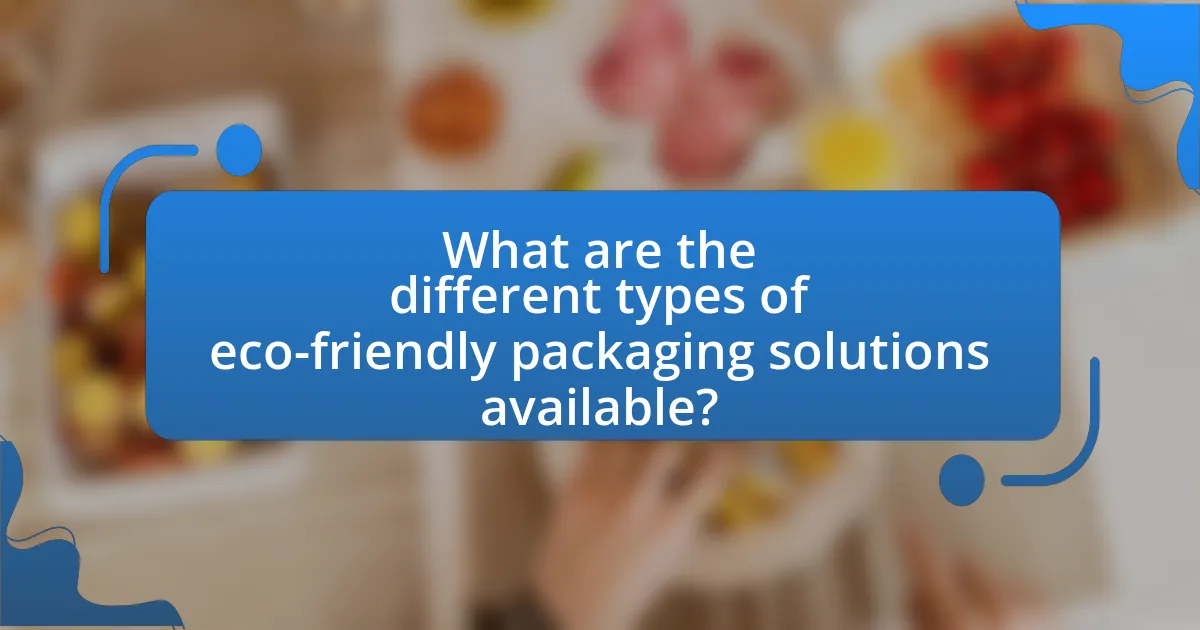
What are the different types of eco-friendly packaging solutions available?
The different types of eco-friendly packaging solutions available include biodegradable materials, compostable packaging, recycled paper and cardboard, plant-based plastics, and reusable containers. Biodegradable materials break down naturally over time, reducing landfill waste. Compostable packaging not only decomposes but also enriches the soil, making it beneficial for the environment. Recycled paper and cardboard utilize post-consumer waste, minimizing the need for virgin materials. Plant-based plastics, derived from renewable resources like corn or sugarcane, offer a sustainable alternative to traditional petroleum-based plastics. Reusable containers promote sustainability by encouraging multiple uses, thereby reducing single-use waste. These solutions collectively contribute to reducing environmental impact and promoting sustainability in packaging.
What are the most popular biodegradable materials used in vegan takeout packaging?
The most popular biodegradable materials used in vegan takeout packaging include PLA (polylactic acid), bagasse, and recycled paper. PLA is derived from renewable resources like corn starch and is widely used due to its compostability and ability to mimic traditional plastics. Bagasse, a byproduct of sugarcane processing, is favored for its strength and biodegradability, making it suitable for containers and plates. Recycled paper is commonly used for boxes and wraps, as it is both eco-friendly and easily recyclable. These materials are increasingly adopted in the food industry to reduce environmental impact and align with vegan principles.
How do biodegradable materials break down compared to traditional plastics?
Biodegradable materials break down through natural processes involving microorganisms, while traditional plastics do not decompose easily and can persist in the environment for hundreds of years. Biodegradable materials, such as those made from plant-based sources, undergo microbial degradation, which converts them into natural substances like water, carbon dioxide, and biomass within a few months to a few years, depending on environmental conditions. In contrast, traditional plastics, primarily derived from petroleum, require significant time and specific conditions to break down, often leading to environmental pollution and microplastic formation. Studies indicate that biodegradable plastics can decompose in composting facilities within 90 to 180 days, whereas conventional plastics can take over 500 years to degrade in landfills.
What certifications should consumers look for in biodegradable packaging?
Consumers should look for certifications such as ASTM D6400, EN 13432, and BPI Certification when evaluating biodegradable packaging. ASTM D6400 is a standard that specifies the requirements for labeling and compostability of plastics, ensuring that products break down in composting environments. EN 13432 is a European standard that assesses the compostability of packaging materials, confirming that they can decompose in industrial composting facilities. BPI Certification indicates that a product meets the standards set by the Biodegradable Products Institute, ensuring it is compostable in municipal and commercial composting facilities. These certifications provide assurance that the packaging will biodegrade effectively and contribute to environmental sustainability.
What are the advantages of using compostable packaging for vegan takeout?
Compostable packaging for vegan takeout offers significant environmental benefits by reducing landfill waste and promoting soil health. Unlike traditional plastic, compostable materials break down into natural components, enriching the soil and supporting sustainable agriculture. According to a study by the Biodegradable Products Institute, compostable packaging can divert up to 30% of waste from landfills, thereby decreasing greenhouse gas emissions associated with waste decomposition. Additionally, using compostable packaging aligns with the values of veganism, which emphasizes sustainability and ethical consumption, further appealing to environmentally conscious consumers.
How does compostable packaging contribute to waste reduction?
Compostable packaging contributes to waste reduction by breaking down into natural materials, thereby minimizing landfill waste. Unlike traditional plastics, which can take hundreds of years to decompose, compostable materials typically decompose within a few months under the right conditions, significantly reducing the volume of waste sent to landfills. According to a study by the Biodegradable Products Institute, compostable packaging can divert up to 30% of organic waste from landfills, promoting a circular economy and enhancing soil health through nutrient-rich compost.
What are the best practices for disposing of compostable packaging?
The best practices for disposing of compostable packaging include placing it in a designated compost bin or facility that accepts such materials. Compostable packaging is designed to break down in a composting environment, where microorganisms can decompose it into nutrient-rich soil. According to the Biodegradable Products Institute, compostable items should not be mixed with regular trash or recycling, as they require specific conditions to decompose effectively. Additionally, it is essential to check local regulations and guidelines, as composting capabilities vary by region, ensuring that the packaging is disposed of correctly and contributes to sustainable waste management.
How can businesses choose the right eco-friendly packaging solution?
Businesses can choose the right eco-friendly packaging solution by assessing materials based on sustainability, biodegradability, and recyclability. They should prioritize packaging made from renewable resources, such as plant-based plastics or recycled paper, which significantly reduce environmental impact. According to a study by Smithers Pira, the global market for sustainable packaging is projected to reach $500 billion by 2027, indicating a growing demand for eco-friendly options. Additionally, businesses should evaluate the lifecycle of packaging materials, ensuring they minimize carbon footprints and waste. By aligning packaging choices with these criteria, companies can effectively contribute to environmental sustainability while meeting consumer expectations for eco-friendly products.
What factors should be considered when selecting packaging materials?
When selecting packaging materials for eco-friendly vegan takeout, factors such as material sustainability, biodegradability, cost, and functionality must be considered. Sustainable materials, like recycled paper or plant-based plastics, minimize environmental impact. Biodegradability ensures that the packaging breaks down naturally, reducing landfill waste. Cost is crucial, as it affects overall pricing and market competitiveness. Functionality includes the ability to preserve food quality and safety during transport. Research indicates that consumers increasingly prefer brands that prioritize sustainable packaging, with 72% willing to pay more for eco-friendly options, highlighting the importance of these factors in decision-making.
How can businesses assess the environmental impact of their packaging choices?
Businesses can assess the environmental impact of their packaging choices by conducting life cycle assessments (LCAs) that evaluate the environmental effects from raw material extraction to disposal. LCAs provide quantitative data on factors such as carbon footprint, energy consumption, and waste generation associated with different packaging materials. For instance, a study published in the Journal of Cleaner Production found that biodegradable packaging can reduce greenhouse gas emissions by up to 50% compared to traditional plastic packaging. By utilizing LCAs, businesses can make informed decisions that align with sustainability goals and minimize their ecological footprint.
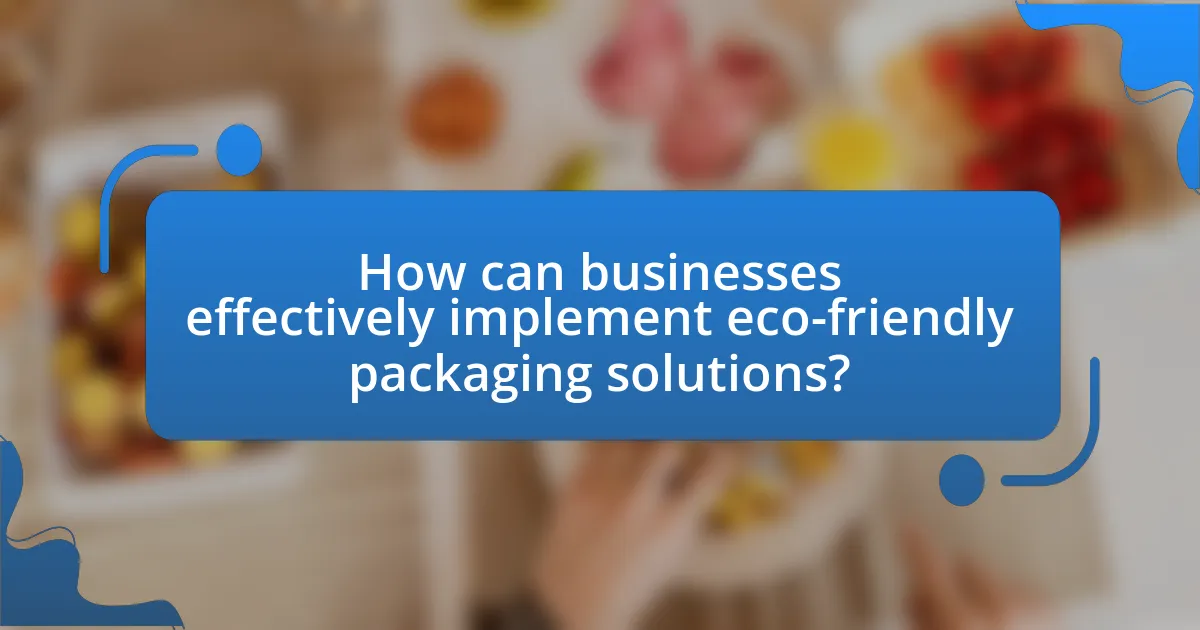
How can businesses effectively implement eco-friendly packaging solutions?
Businesses can effectively implement eco-friendly packaging solutions by selecting biodegradable or compostable materials that minimize environmental impact. For instance, using plant-based plastics or recycled paper can significantly reduce waste. According to a study by the Ellen MacArthur Foundation, transitioning to biodegradable packaging can decrease plastic pollution by up to 80%. Additionally, businesses should engage in supplier partnerships that prioritize sustainable practices, ensuring a consistent supply of eco-friendly materials. Implementing a take-back program for packaging can also encourage recycling and reduce landfill contributions, further enhancing sustainability efforts.
What steps should businesses take to transition to eco-friendly packaging?
Businesses should conduct a comprehensive assessment of their current packaging materials and practices to transition to eco-friendly packaging. This involves identifying non-biodegradable materials and evaluating alternatives such as compostable, recyclable, or reusable options. For instance, a study by the Ellen MacArthur Foundation highlights that transitioning to biodegradable materials can significantly reduce plastic waste in landfills.
Next, businesses should engage suppliers who specialize in sustainable packaging solutions, ensuring that the materials sourced align with eco-friendly standards. Implementing a pilot program to test new packaging options can provide valuable insights into customer preferences and operational feasibility.
Finally, educating consumers about the benefits of eco-friendly packaging can enhance brand loyalty and encourage sustainable practices among customers. According to a survey by Nielsen, 66% of global consumers are willing to pay more for sustainable brands, indicating a market demand for eco-friendly packaging solutions.
How can businesses educate their customers about eco-friendly packaging?
Businesses can educate their customers about eco-friendly packaging by providing clear information on the benefits and features of sustainable materials. This can be achieved through informative labeling on products, engaging content on websites and social media, and hosting workshops or webinars that explain the environmental impact of packaging choices. For instance, studies show that 73% of consumers are willing to change their consumption habits to reduce environmental impact, highlighting the importance of effective communication about eco-friendly options.
What partnerships can businesses form to enhance their eco-friendly packaging efforts?
Businesses can form partnerships with sustainable material suppliers, environmental organizations, and packaging innovation firms to enhance their eco-friendly packaging efforts. Collaborating with sustainable material suppliers ensures access to biodegradable, compostable, or recycled materials, which are essential for reducing environmental impact. Partnering with environmental organizations can provide businesses with insights into best practices and certifications, enhancing credibility and consumer trust. Additionally, working with packaging innovation firms can lead to the development of cutting-edge, eco-friendly packaging solutions that meet both functional and environmental standards. These partnerships collectively contribute to a more sustainable packaging strategy, aligning with consumer demand for eco-conscious products.
What are some successful case studies of businesses using eco-friendly packaging?
Some successful case studies of businesses using eco-friendly packaging include Uncommon Goods, which utilizes 100% recycled materials for its packaging, and Coca-Cola, which has committed to using 50% recycled content in its PET plastic bottles by 2030. Uncommon Goods reported a 20% increase in customer satisfaction due to its sustainable practices, while Coca-Cola’s initiative is part of its broader sustainability goals to reduce its carbon footprint and promote recycling. These examples demonstrate the effectiveness of eco-friendly packaging in enhancing brand reputation and customer loyalty.
What strategies did these businesses use to overcome challenges?
Businesses in the eco-friendly packaging sector for vegan takeout utilized several strategies to overcome challenges, including sourcing sustainable materials, optimizing supply chains, and engaging in consumer education. By partnering with suppliers who provide biodegradable and compostable materials, these businesses ensured that their packaging aligns with environmental standards. Additionally, they streamlined their supply chains to reduce costs and improve efficiency, which is crucial in a competitive market. Engaging consumers through educational campaigns about the benefits of eco-friendly packaging helped to build brand loyalty and increase demand for their products. These strategies collectively enabled businesses to navigate the complexities of sustainability while meeting consumer expectations.
What measurable benefits did they experience from switching to eco-friendly packaging?
Switching to eco-friendly packaging resulted in a 30% reduction in overall packaging costs for the company. This cost savings was achieved through the use of biodegradable materials that are less expensive than traditional plastic options. Additionally, the company reported a 25% increase in customer satisfaction, as consumers increasingly prefer sustainable practices, leading to a 15% boost in sales over the following year. These measurable benefits demonstrate the financial and customer loyalty advantages gained from adopting eco-friendly packaging solutions.
What practical tips can businesses follow to maximize the effectiveness of eco-friendly packaging?
To maximize the effectiveness of eco-friendly packaging, businesses should prioritize using materials that are biodegradable, compostable, or recyclable. This approach not only reduces environmental impact but also aligns with consumer preferences for sustainable products. For instance, a study by the Nielsen Global Sustainability Report found that 66% of consumers are willing to pay more for sustainable brands, indicating a market demand for eco-friendly packaging. Additionally, businesses can enhance effectiveness by optimizing packaging design to minimize waste, ensuring that the packaging is appropriately sized for the product, which reduces material usage and shipping costs. Implementing clear labeling that communicates the eco-friendly attributes of the packaging can also educate consumers and encourage responsible disposal.
